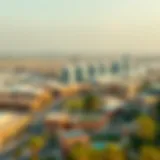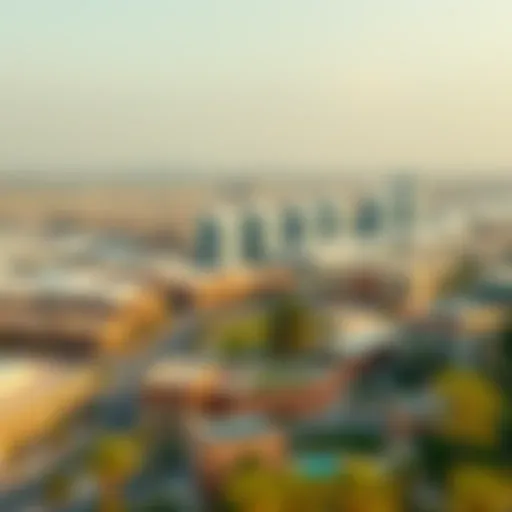Exploring the Jebel Ali Palm Project's Impact on Dubai
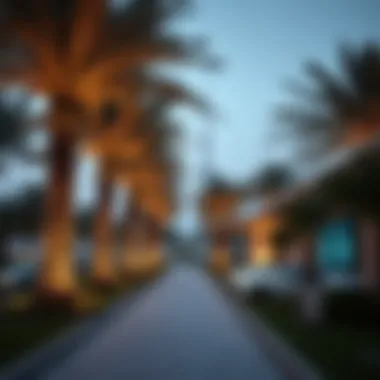

Intro
The Jebel Ali Palm Project stands as a testimony to the audacity and innovation driving Dubai's urban evolution. From its bold conceptual design to the intricate engineering feats required for its realization, this initiative is more than just a developmental project; it’s a paradigm shift in how cities can harmonize with their coastal environments.
As we dive into the heart of this project, we'll peel back the layers to understand not only its architectural significance but also its impact on the real estate landscape of Dubai. The motivations behind such grand designs are complex and multifaceted, necessitating a thorough exploration to appreciate fully the implications for investors and residents alike.
Market Trends
Current Market Analysis
In recent years, Dubai's property market has been sizzling hot, showing resilience despite global economic fluctuations. The Jebel Ali Palm Project is poised to accentuate this trend further, attracting a mix of local and international investors. Current property values in surrounding areas have witnessed a steady incline, fueled by optimism surrounding new developments.
- Increased Demand: The allure of luxury living coupled with world-class amenities on the Palm has spurred interest among affluent buyers and expatriates seeking opulent lifestyles.
- Rental Market Surge: The rental properties on the Palm offer attractive returns, positioning it as a prime location for property investment.
- Diversification of Offerings: With the introduction of mixed-use developments, investors now have choices ranging from residential units to commercial spaces, appealing to a broader audience.
Future Predictions
Considering the ambitious nature of the Jebel Ali Palm Project, we can anticipate several future trends:
- Sustained Price Appreciation: Experts suggest property prices are likely to appreciate as the project approaches completion, driven by increasing demand for waterfront living.
- Infrastructure Development: Enhanced transport links and public transport options are expected to make the area even more accessible, boosting property values further.
- Environmental Considerations: As sustainability becomes a priority, eco-friendly initiatives developed through the project may set benchmarks for future developments, influencing property desirability.
Property Investment Insights
Types of Investment Properties
Investors gearing up to dive into the Jebel Ali market will find various property types that cater to different investment strategies:
- Luxury Villas: Seafront villas are likely to offer the highest return, appealing to affluent families and individuals.
- Apartments: High-rise living is attracting younger demographics, keen on urban lifestyles with easy access to amenities.
- Commercial Spaces: As businesses flock to the area, retail spaces and offices are emerging as lucrative opportunities.
Financing Options and Tips
For those interested in entering this vibrant market, it’s crucial to explore financing avenues effectively:
- Mortgages: Many banks offer attractive mortgage deals tailored for expatriates. Understanding the local banking landscape can help secure favorable terms.
- Investment Funds: Real estate investment trusts (REITs) related to the project should also be on investors' radars, providing an indirect way to access potential returns.
- Professional Guidance: Engaging with real estate agents familiar with the Jebel Ali Palm landscape can provide invaluable insights and streamline the investment process.
In summary, the Jebel Ali Palm Project isn’t just changing the face of Dubai; it could also redefine property trajectories regionally and globally. Its ongoing development brings a host of opportunities, poised to captivate hearts and challenge minds in the ever-evolving real estate landscape.
Prologue
The Jebel Ali Palm Project is not merely an ambitious architectural endeavor; it reflects the very essence of modern development in Dubai, capturing attention worldwide. This sprawling initiative highlights an unmatched blend of creativity and engineering prowess, setting the stage for diverse economic and social impact. In a city known for its dynamic transformations, understanding the importance of this project provides crucial insights into Dubai's future and the real estate landscape.
Key Elements of the Jebel Ali Palm Project
At its core, the project seeks to introduce:
- Luxury Living: Innovative residential designs that promise a lavish lifestyle intertwined with nature.
- Economic Growth: Aimed at boosting investments and creating substantial return on investment through premium properties.
- Cultural Spaces: Areas that reflect the unique blend of history and contemporary flair that defines Dubai.
- Sustainability: Integrating green practices and technologies to reduce the environmental footprint.
Benefits and Considerations
For investors, this project serves as a golden opportunity to engage with real estate in a growing market. The allure of Jebel Ali Palm lies not only in its aesthetic charm but also in its potential for substantial profit. These factors are crucial for potential buyers and other stakeholders looking to navigate the landscape of Dubai's property sector. Furthermore, understanding the historical context of palm projects in Dubai adds depth to this examination, presenting a narrative rich in ambition, challenges, and triumphs.
This article aims to provide a rounded view of the Jebel Ali Palm Project, exploring all facets from its architectural vision to its impact on local ecosystems. By delving into these elements, readers can grasp not just the strategic importance of the project, but also how it aligns with broader urban planning trends in coastal areas. The journey of the Jebel Ali Palm is a testament to Dubai’s forward-thinking ethos and its commitment to redefining urban environments.
Design and Architecture
Understanding the design and architecture of the Jebel Ali Palm Project is crucial to appreciate its significance within Dubai’s urban landscape. This section explores how creativity meets functionality, and the role it plays in the city's evolving identity. The Palm Project embodies not just a modern lifestyle but also represents a conscious effort in urban planning—addressing environmental, social, and aesthetic needs in a balanced manner.
Architectural Vision Behind the Project
At the heart of the Jebel Ali Palm Project is a vibrant architectural vision that aims to blend luxury with nature. The overall design mirrors the natural palm trees, embracing the theme of harmonious living amid urban textures. Wrapped within this vision is a diverse range of residential and commercial spaces, each thoughtfully planned to enhance the overall aesthetic and functionality of the area.
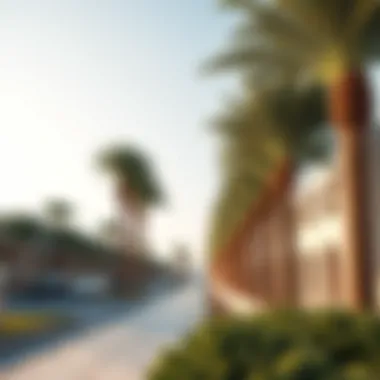

- Innovative layouts promote a sense of community while ensuring privacy.
- Mixed-use developments provide residents with easy access to essential services without straying far from their homes.
The architects have employed local materials and traditional design elements to echo the rich cultural heritage of Dubai. With towering edifices and sprawling waterfronts, this alignment of modern ingenuity with local traditions purposes not just to attract foreign investment but to foster a sense of belonging among residents.
Innovative Engineering Solutions
The engineering solutions adopted for the Jebel Ali Palm Project are nothing short of revolutionary. They address both the logistical challenges of building in a coastal environment and the rigorous demands of sustainability. A few noteworthy alternatives have emerged during the design and construction phases:
- Advanced Geotechnical Methods: Specialized soil compositions and large-scale excavation strategies were deployed to ensure stability in a marine environment.
- Modular Construction Techniques: These methods reduced construction time and waste, leading to a more efficient building process without compromising on quality.
- State-of-the-art Infrastructure: An extensive road network, coupled with smart transportation solutions, facilitates seamless movement inside and outside the project.
These measures showcase a commitment to not only contemporary engineering but also resilience against natural calamities, which is vital considering the site's geographic disposition.
Integration of Sustainable Practices
The integration of sustainable practices within the Jebel Ali Palm Project is a message of responsibility toward both the environment and future urban development. Striking a balance between luxury and eco-friendliness, the development is committed to minimizing its carbon footprint and conserving natural resources. Strategies include:
- Utilization of Renewable Energy: Solar panels harness the sun's energy, reducing dependence on non-renewable sources.
- Water Management Systems: Innovative waste-water recycling ensures that water is responsibly used and reused, contributing to the local ecosystem.
- Green Spaces: Ample parks and waterfront promenades allow residents to engage with nature, promoting well-being while fostering biodiversity.
This holistic approach makes the Jebel Ali Palm Project not just an architectural feat but also a blueprint for future developments in the region, setting a high standard for integrating modern living with environmental stewardship.
As we can see, the design and architecture of the Jebel Ali Palm Project do way more than just create housing and commercial spaces. They offer a template for how modern urban developments can harmonize with the ecological landscape, making them a critical aspect of this comprehensive examination.
Geographical Significance
The geographical significance of the Jebel Ali Palm Project can’t be overstated. Located on the southwestern coast of Dubai, the project occupies a prime area that has both historical and economic relevance. With its strategic positioning alongside the Persian Gulf, it serves not just as a visual landmark but also influences transport, tourism, and trade in the region. Understanding the geographical aspects of this project allows for a deeper appreciation of its implications on both the local and broader scales.
Location and Accessibility
The location of the Jebel Ali Palm Project is a critical factor in its success. Nestled near the Jebel Ali Port, one of the busiest ports in the world, it benefits immensely from proximity to maritime trade routes. This not only enhances accessibility for tourists but makes it easier for businesses to operate in the area.
- Easy Access: The project is connected by major highways, including the Sheikh Zayed Road, ensuring convenient travel to and from the city center.
- Transport Links: The project is well-serviced by the Dubai Metro, an advantage for residents and visitors, connecting them to other key parts of the city.
Unique Features of the Location
The geography also plays a role in shaping residential and commercial offerings. With breathtaking views of the Arabian Gulf, every unit and retail space is designed to maximize the connection between nature and urban life.
“The strategic location of Jebel Ali Palm not only enhances real estate value but also sets a benchmark for future developments along coastal areas.”
Impact on Local Ecosystems and Marine Life
An understanding of the impact on local ecosystems and marine life is vital when examining the Jebel Ali Palm Project. The construction and ongoing development processes pose significant challenges and considerations.
- Biodiversity Risks: The area is home to various marine species, and any disruption in their habitat could have cascading effects. Efforts to mitigate damage include ecological assessments prior to construction.
- Sustainable Practices: To counterbalance potential environmental harm, the project integrates advanced technology for monitoring marine health and aims to establish marine parks that aid in ecosystem recovery.
Conversations around adaptive strategies bring to light the profound responsibility developers face. Understanding these dimensions emphasizes that urban growth can coexist with environmental stewardship, shaping a more sustainable future for Dubai.
To dive deeper, resources like Britannica and Wikipedia provide extensive insight on geography's role in urban development, potentially serving as guiding references for investors and stakeholders intrigued by similar coastal projects.
Economic Implications
The Jebel Ali Palm Project stands at the intersection of urban innovation and economic strategy. Understanding its economic implications is crucial not only for discerning investors and agents but also for buyers and expats looking for opportunities in Dubai. The project promises to influence local markets, attract international investments, and spur job creation, which collectively reshape the economic landscape of the region.
Investment Potential and ROI
The Jebel Ali Palm Project presents a ripe ground for investment opportunities. Investors often seek projects that promise substantial returns, and this development is not one to be overlooked. Its unique location and ambitious vision offer potential high yields. Often, new real estate developments in Dubai appreciate in value rapidly, and the Palm Project is positioned to follow suit. However, understanding the cycle of real estate and the prevailing economic conditions is paramount.
A possibility exists for various investment vehicles, ranging from residential sales to commercial leases. With luxury amenities and a distinct lifestyle on offer, the project is attractive to high-net-worth individuals seeking both personal residences and profitable investments.
- Key Considerations:
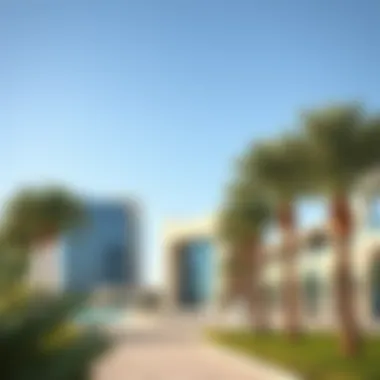

- Market trends in Dubai’s real estate and historical growth rates.
- Infrastructure investments that enhance accessibility and desirability.
- The long-term economic policies of Dubai and how they foster secure investment environments.
Effects on Local and Global Real Estate Markets
On the local front, the Jebel Ali Palm Project cultivates a ripple effect across the broader Dubai real estate market. The introduction of high-caliber properties influences property values in adjacent areas, elevating the profiles of previously less sought-after locations. This can lead to an overall boost in property demand and a rise in the local housing market.
Globally, luxury and unique developments like this attract international attention, which can lead to increased foreign investments. As Dubai’s status as a global business hub solidifies, the Jebel Ali Palm Project could become a touchstone for similar developments across the world, particularly in coastal urban areas.
Job Creation and Economic Growth
Projects of this scale necessitate a significant workforce, which translates into job creation across various sectors. From construction trades to hospitality management, the Jebel Ali Palm Project is set to generate thousands of jobs. These new employment opportunities will likely attract a fresh wave of expat talent, contributing to Dubai’s multicultural workforce.
Moreover, as jobs increase, so does consumer spending, which can serve to stimulate the economy at large. Local businesses may also benefit from the increased foot traffic and expendable incomes as new residents and employees settle in.
- Economic Growth Factors:
- Construction jobs during the project's build phase.
- Long-term jobs in hospitality, retail, and service sectors once the project is operational.
- Architectural and engineering roles tied to continuous improvements and expansions.
In sum, the economic implications of the Jebel Ali Palm Project are far-reaching. From influencing investment trends and real estate practices to stimulating economic growth through job creation, its impact is poised to reshape the landscape of Dubai significantly. This project should be seen not only as a development but as a catalyst for a new economic era in the region.
"Real estate and the economy are two sides of the same coin; as one thrives, the other follows."
For more context on Dubai’s economy and real estate, you may visit Wikipedia and Britannica.
Challenges Faced
Understanding the challenges faced by the Jebel Ali Palm Project is crucial for grasping the complexities involved in such a monumental undertaking. These challenges do not merely serve as obstacles; they are critical factors that influence the project's trajectory and its eventual success or failure. Navigating regulatory frameworks, addressing environmental concerns, and wrestling with technological limitations provide a comprehensive backdrop against which this ambitious development must be analyzed. This section aims to explore these facets in detail, equipping investors, expats, agents, managers, and potential buyers with insights into what makes or breaks such extensive projects.
Regulatory and Bureaucratic Hurdles
The regulatory environment surrounding large construction projects in Dubai can be multifaceted, characterized by a set of rules and standards that developers must adhere to. The Jebel Ali Palm Project, while no exception, faced its own share of red tape. These bureaucratic hurdles often delay timelines and increase costs, impacting investment potential and overall project viability.
- Permitting Processes: Securing the necessary permits can take considerable time. Regulatory authorities assess aspects such as structural integrity, environmental impact, and safety considerations. This can lead to prolonged waiting periods, causing frustration among stakeholders.
- Compliance Standards: Each phase of development must align with local and international standards. This means having extensive documentation and sometimes reshaping existing plans to stay compliant.
- Stakeholder Engagement: Engaging with local communities and stakeholders is essential yet can introduce complications. Balancing the interests of existing residents with the goals of new developments adds another layer of complexity.
"With any expansive urban project, navigating red tape is as much a part of construction as laying bricks and mortar."
Environmental Obstacles
The environmental challenges associated with the Jebel Ali Palm Project cannot be overlooked. As Dubai continues to expand its urban footprint, the balance between development and the environment becomes even more delicate. Particular areas of concern include:
- Marine Life Protection: Given the project's coastal nature, preserving marine ecosystems is critical. Any disturbance from construction activities can have adverse effects on local biodiversity.
- Sustainability Practices: Pressure to employ environmentally friendly methods complicates planning. The use of resources, waste management, and sustainability in construction all come under scrutiny, necessitating innovative approaches.
- Climate Factors: The region's climate poses its own set of challenges. High temperatures and occasional sandstorms can lead to delays, requiring contingency plans that can stretch budgets.
Technological Limitations
The realm of technology, while a facilitator of modern construction, comes with its own limitations. Even with advancements, the Jebel Ali Palm Project encountered technical challenges that required innovative problem solving.
- Infrastructure Needs: Building on a man-made island demands cutting-edge infrastructure to support utilities and transport. Limited existing technology necessitates customized solutions, which can be time-consuming.
- Construction Techniques: Some advanced construction techniques that work in other environments might not be applicable here. Each method needs careful evaluation based on the unique characteristics of the local geology and weather.
- Innovation Pace: Staying abreast of the latest tech trends is vital. However, implementation often lags behind research and development, impacting project timelines and budgets.
In summary, the Jebel Ali Palm Project stands at a crossroads shaped by regulatory frameworks, environmental concerns, and technological requirements. Each of these challenges holds a mirror up to the complexities of modern urban development, illustrating that success isn't simply defined by completion but by responsible and sustainable growth. For interested stakeholders, grasping these challenges is vital for informed decision-making in the context of investment and development within Dubai's evolving landscape.
Community and Lifestyle
The Community and Lifestyle aspect of the Jebel Ali Palm Project stands as a crucial pillar in understanding its broader implications. This section explodes the idea that urban development is not just about towering skyscrapers and luxury apartments—it's also about the people who will inhabit these spaces. In fact, successful developments hinge on creating inviting environments that foster community spirit and enhance the quality of life. For investors, expats, and potential residents, this aspect becomes integral when weighing the benefits of living in such an innovative locale.
Residential Offerings and Amenities
One cannot underestimate the significance of residential offerings in the Jebel Ali Palm Project. Picture a neighborhood that caters not just to the upper strata of society, but opens its arms to diverse demographics. The designers of this project seem to have thought of every corner, offering something for everyone. Contemporary villas with breathtaking sea views, modern apartments equipped with state-of-the-art appliances, and relaxing green spaces dot the landscape.
Amenities such as swimming pools, gyms, and play areas provide residents with easy access to leisure and recreation. These facilities aren’t mere add-ons; they are foundational elements that promote a community's health and well-being. You might step out of your home to find a bustling café, shops offering artisanal goods, or perhaps a quiet park for a peaceful stroll. The planning here clearly emphasizes connectivity and engagement, encouraging neighbors to become familiar faces instead of strangers.
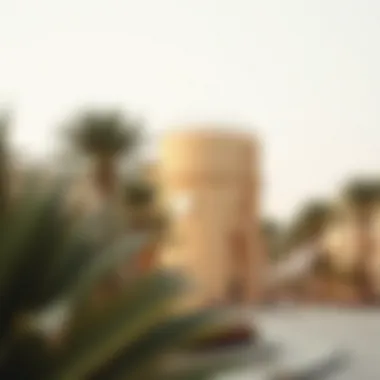

- Key Amenities Available:
- Swimming pools and fitness centers
- Parks and playgrounds
- Retail spaces and eateries
- Walking and cycling paths
These offerings not only attract residents but also weave a tapestry of community life that enriches day-to-day living.
Cultural and Recreational Aspects
In delving into the Cultural and Recreational Aspects of the Jebel Ali Palm Project, one cannot overlook the advantages it brings in nurturing a vibrant community. The intention behind this development goes beyond mere aesthetics; it aims to forge a coherent identity rooted in both tradition and modernity. Cultural centers, art galleries, and performance venues are all strategic components that signal the project’s commitment to cultural enrichment.
Moreover, recreational facilities can foster communal interactions through sports and cultural events. Imagine weekend art fairs, local music concerts, or workshops where families can engage and collaborate. These initiatives not only provide entertainment but also serve as social equalizers, helping diverse backgrounds mingle in a shared space of joy and creativity.
"Cultural experiences can bind communities together, turning a collection of houses into a thriving neighborhood."
With a rich blend of activities—from local art exhibitions to international food festivals—such events are sure to leave a lasting impression on both residents and visitors alike. This vital mixture of community engagement and cultural exploration thus reinforces the idea that the Jebel Ali Palm Project may just be the new heart of Dubai, where lifestyle meets luxury and diversity flourishes amid an intricate social fabric.
In sum, the Community and Lifestyle segment of the Jebel Ali Palm Project is not an afterthought; it’s a thoughtfully crafted narrative that focuses on cultivating interactions, enriching lives, and opening up new avenues for every stakeholder involved.
Future Prospects
As the Jebel Ali Palm Project continues to evolve, its future prospects are important not just for Dubai, but for urban development models around the world. This section details how the project is not merely an isolated enterprise but a touchstone for forward-thinking coastal developments. The insights gleaned here can help investors, real estate professionals, and urban planners gauge potential growth opportunities in an ever-changing market.
Long-term Vision for Jebel Ali Palm
The long-term vision for the Jebel Ali Palm is multifaceted and ambitious. With sustainability increasingly at the forefront of urban development, the project aims to incorporate green infrastructure while maintaining economic viability. This vision is reflected in the commitment to developing eco-friendly residential and commercial spaces that harmonize with the natural environment.
A significant element of this vision involves creating a thriving community, complete with parks, recreational facilities, and cultural spaces. The objective is to foster not only residential life but also an environment where businesses can flourish. This aligns with Dubai's broader goal of positioning itself as a global hub for tourism and business. The integration of technology, such as smart city solutions, ensures that urban management will adapt to the needs of residents and visitors over the coming decades.
In essence, the long-term vision is to create a space that is not just livable but also enjoyable. The allure of the waterfront, combined with top-notch amenities, aims to attract a diverse mix of expats, investors, and families, making the Jebel Ali Palm a desirable location for a broad audience.
Potential for Further Development and Expansion
As the project advances, there’s a palpable excitement around the potential for further development and expansion. The Jebel Ali Palm is designed not only as a completed development but as a foundational blueprint for future initiatives.
Unpacking this potential means acknowledging several critical aspects:
- Economic Viability: Market analyses indicate strong demand for luxury real estate in the region. This demand can spur additional investment from both local and international financiers.
- Community Engagement: As the area develops, engaging with the community can result in identifying new needs and opportunities for facilities that further enhance the quality of life. Events, markets, and public spaces can evolve organically through active dialogue with residents.
- Innovative Technologies: The incorporation of cutting-edge technologies, such as renewable energy sources and smart infrastructure, lays the groundwork for a modern urban ecosystem. This approach not only enhances sustainability but also makes the development appealing to tech-savvy residents.
"The Jebel Ali Palm is not just about land; it's about shaping a future where sustainability meets luxury, creating a vibrant community for coming generations."
For those interested in keeping up with development efforts, resources such as Dubai Property offer ongoing updates. For a broader perspective on urban growth and real estate trends, insights can be found on sites such as LinkedIn or industry-focused publications on Inman.
Culmination
The Jebel Ali Palm Project stands as a testament to visionary urban planning and ambitious infrastructural development in Dubai. In this article, we have explored the project's myriad dimensions, from its architectural elegance to its economic implications. In doing so, we have focused not only on the tangible aspects but also on the broader themes of sustainability and community that underpin such grand initiatives.
Summary of Key Insights
In understanding the Jebel Ali Palm Project, several key insights emerge:
- Architectural Innovation: The project utilizes cutting-edge engineering solutions that redefine the concept of architectural beauty in coastal developments.
- Economic Viability: Investment potential remains high, given the project's impact on local and global property markets. The expected ROI is compelling for potential stakeholders.
- Environmental Concerns: Balancing development with ecological preservation is crucial. Strategies to mitigate environmental impact continue to evolve within the context of ongoing progress.
- Community Engagement: The lifestyle offerings cater to a diverse population, promoting cultural richness and recreational opportunities for residents and tourists alike.
These insights not only articulate the potential benefits but also highlight considerations that stakeholders must navigate as the project progresses.
Final Thoughts on the Impact of Jebel Ali Palm Project
As we reflect on the Jebel Ali Palm Project, its influence extends beyond mere urban development. It encapsulates a vision for future cities where sustainability, luxury, and innovation coalesce. The integration of advanced technologies and environmentally sustainable practices sets a precedent for similar projects worldwide.
Moreover, this project illuminates the potential for real estate to significantly stimulate economic growth, creating jobs and attracting international investment. In a global landscape increasingly driven by urbanization, the lessons learned from the Jebel Ali Palm Project will resonate, serving as a touchstone for future developments.
"Urban planning is not merely about building structures. It is about constructing a living ecosystem that thrives on innovation, sustainability, and community."
The path ahead for Jebel Ali Palm is paved with exciting possibilities, where the intersection of modernity and tradition may pave the way for transformative urban living. Investors and stakeholders involved in this project will want to track these developments closely as they unfold in the coming years.
As we conclude this examination, it is clear that the Jebel Ali Palm Project will leave a lasting mark on Dubai, reshaping its landscape and inspiring future endeavors within global urban planning.
